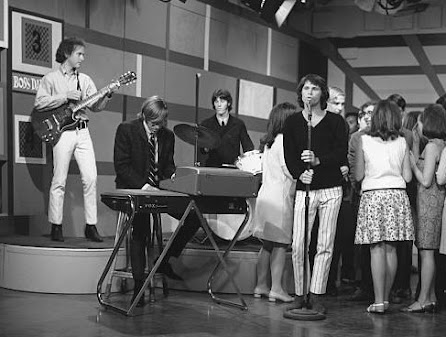FACE AS A METAPHOR: THE DOORS’ "I CAN'T SEE YOUR FACE IN MY MIND" AND OTHER SONGS
Jim Morrison was a poet and a great musician who could express himself
with great warmth in both fields, arousing strong emotions.
This talent is evident in the lyrics he wrote for The Doors, much like
the light of the stars is reflected in the eyes of a lonely fisherman on a lake
at night.
The band's second LP, "Strange Days" (released in September
1967), contains many examples of his expressive talent.
Take, for instance, "I Can't See Your Face in My Mind", the
ninth track on this wonderful record. In this song, the singer delivers a
monologue to the girl he is about to leave, using words steeped in sadness.
Indirectly communicating his feelings, he uses the image of the girl's
face, which he cannot visualize in his mind.
In this way, Morrison summarizes the fading of his love for her: her
face represents both her and the love they once shared.
Morrison was not alone in using this poetic-narrative technique during
this golden age of contemporary music. Although less effective than The Doors’
frontman in capturing the listener's imagination, other musicians also evoked
the image of the beloved girl's face in their lyrics.
A good example of this trend is "Have You Seen Her Face" by The Byrds, in which the same metaphor is employed, this time with a positive connotation (link here).
Written by bassist Chris Hillman, this song was released in early 1967
on the album "Younger Than Yesterday", the last LP by the group with
the original line-up.
Here, the face of the loved one serves as a window into the narrator's
feelings of attraction.
Nevertheless, the lyrics maintain a point of contact with those of
"I Can't See Your Face in My Mind", in fact both songs use the word
"face" as a device to refer to the beloved.
Musically, "Have You Seen Her Face" is a medium-paced pop-rock
song that combines fine melodies with the slightly distorted guitar sound that
is characteristic of The Byrds.
A couple of short but lively electric guitar solos round off a very
pleasing band performance.
A similar example can be found in The Beatles' "I've Just Seen a Face" (link here) where the face in the title represents the girl the protagonist has fallen in love with and cannot forget.
Written by Paul McCartney, the song appeared on "Help", the
Beatles' fifth LP, released in August 1965.
Displaying his well-known versatility, the bassist switches to the
acoustic guitar to write an intense song that is both fast and poetic and of
great quality and impact.
"I've Just Seen a Face" can be placed in the realm of folk
rock, a genre that was at the height of its popularity on both sides of the
Atlantic in 1965.
The verse in particular stands out for its beauty and smoothness.
Moreover, the verse's melody line is also reprised and reworked during the development of the guitar
solo.
As we have seen, Morrison and other famous artists of the time tended to
depict girls' faces as a means of expressing their feelings.
Sometimes they were sad, as at the end of a love affair ("I Can't
See Your Face in My Mind") while at other times they celebrated a strongly
desired feeling.
P.S.: My book "The Doors Through Strange Days"- The most comprehensive journey ever made through The Doors' second LP, is available on Amazon.com, .uk, .mx, .it, etc.
Here’s a link:




Comments
Post a Comment